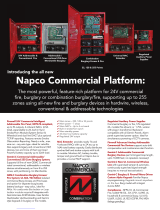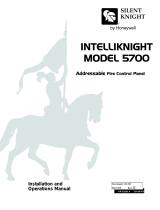
FireNETPlusI&OManual
Version1.09Page3
Section 4 – Expander Board Installation
....................................................................................................................................................... 38
4.1 Compatible Expander Boards ................................................................................ 38
4.2 General Installation of RS-485 Bus Devices .......................................................... 38
4.2.1 Wiring Distance and Mounting Locations.......................................................... 38
4.2.2 Addressing ........................................................................................................ 39
4.2.3 Terminating ....................................................................................................... 39
4.2.4 Power Connections .......................................................................................... 40
4.2.5 COMMS Connection ......................................................................................... 40
4.3 FN-4127-IO - Input / Output Board ........................................................................ 41
4.3.1 Configuring Inputs ............................................................................................ 41
4.3.2 Configuring Outputs .......................................................................................... 42
4.3.3 LED Indicators .................................................................................................. 43
4.6 FNP-1127-SLC – SLC Loop Expander .................................................................. 44
4.6.1 Installation of the FNP-1127-SLC ..................................................................... 44
4.7 FN-LCD-S Serial Liquid Crystal Display Annunciator ............................................ 45
4.7.1 Installation of the FN-LCD-S ............................................................................. 45
Section 5 – SLC Device Installation
....................................................................................................................................................... 48
5.1 Compatible SLC Devices ....................................................................................... 48
5.2 Number of Devices ................................................................................................ 49
5.3 SLC Loop Wiring ................................................................................................... 50
5.3.1 Class B SLC Loop Wiring Distance .................................................................. 51
5.3.2 Class A SLC Loop Wiring Distance .................................................................. 53
5.4 Addressing Devices ............................................................................................... 55
5.4.1 Detector Addressing ......................................................................................... 57
5.4.2 4” Modules and AMS Addressing ..................................................................... 57
5.4.3 Mini Module Addressing ................................................................................... 58
5.5 Smoke and Heat Detector Wiring .......................................................................... 59
5.5.1 ACD-V CO Multi-Sensor Configuration ............................................................... 60
5.6 Analog Duct Detector Wiring ................................................................................. 61
5.6.1 DH98-A Analog Duct Detector .......................................................................... 62
5.6.2 DH98-AR Analog Duct Detector with Relay ...................................................... 62
5.7 FRCME-4 Input Module Wiring .............................................................................. 64
5.8 FRCME-M Mini Input Module (w/ Terminal Blocks) ............................................... 65
5.9 FRCMA / FRCMA-I Input Module .......................................................................... 66
NOTE: For Sections 5.7, 5.8, and 5.9 common for all FRCM devices ......................... 67
5.10 R2M Dual Relay Module Wiring ........................................................................... 68
5.11 SOM Supervised Output Module ......................................................................... 69
5.12 SOM-A / SOM-AI Supervised Class A Output Module ........................................ 70
5.13 SOM-R Supervised Output Module (Preaction Sprinkler Systems) ..................... 72
5.14 CZM Conventional Zone Module ......................................................................... 76
5.15 DIMM Dual Input Monitor Module ........................................................................ 77
5.16 SCI Short Circuit Isolator Module ........................................................................ 78
5.16.1 Class A Operation .......................................................................................... 79
5.16.2 Class B Operation .......................................................................................... 80
5.17 ASB & ASBL Analog Sounder Base .................................................................... 81




























